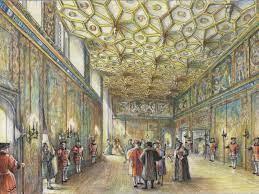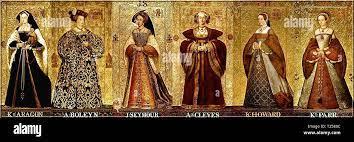People of high social standing were expected to attend court and participate as courtiers. Maintaining a position at court was an expensive business, but the rewards were high if you remained among the monarch’s favourites. However, being aTudor courtier was not always easy, particularly under Henry VIII, who as an ollder man was notoriously easy to enrage.
The King’s household, the royal court was the political and cultural center of the nation, and despite the risks, anyone who was anyone wanted to be there. At court, patronage and favour was given to those who pleased the monarch, and taken away from those who did not.Henry VIII had over 60 homes, but Hampton Court was his favourite palace. Once he had taken it from Cardinal Wolsey, the King transformed it still further to demonstrate his power and magnificence. He also knew that the palace design had to work practically to feed, accommodate and entertain his vast court of aristocrats and their servants.
The long chains of rooms in the palace, each with a guard on the door, were designed to prevent all but the most important gaining access to the monarch’s private spaces. A courtier’s clothes played a vital role in the guards’ decision: the smarter you looked the closer you got to the King
The royal family and the court moved around the country, visiting Henry’s grand houses and palaces for a few months, sometimes even a few hours. When the King left Hampton Court he often used the river Thames to get up to London. He and his queen would travel in the royal barge, surrounded by smaller boats with their closest servants on board carrying clothes and personal possessions.

Courtiers would be expected to pack up and follow the royals on horseback, accompanied by their own servants. A constantly shifting court was necessary; to allow the palaces to be cleaned and human waste removed, and to let surrounding land and livestock to be replenished after supplying the voracious demands of the royal court.
A visitor of high rank would expect to pass through the Great
Hall into the more exclusive rooms beyond. The sequence of rooms included
a Guard Chamber, a Privy or Audience CThe monarch’s most private and heavily
guarded rooms lay beyond the grandest of the public rooms. This inner sanctum
included an eating room, an inner Privy Chamber, a Withdrawing Room and finally
a bedchamber.
Favoured courtiers would be invited to the Withdrawing
room. Only they were allowed to see the monarch in a less formal setting,
perhaps to play games, listen to music or enjoy conversation.
Political power was concentrated among the men who attended to the King’s needs in the magnificence of the inner Privy Chamber. They enjoyed intimate access to the King, washing and dressing him, even attending to him on the close-stool (lavatory).
Those appointed to high positions in the royal household, and
those closest to the king, were male. Depending on their social status, female
courtiers worked in the queen’s household, for example as ladies-in-waiting, or
woman of the bedchamber.
As part of court ‘business’, fathers from the
most powerful families in the land sought positions for their unmarried
daughters. It was an ideal place for them to meet a wealthy husband and make
alliances between families, and while the rewards were high, so were the risks.
These young women were sometimes formally
educated, but it was their social skills that put them most in demand at court
entertainments such as dances and masques. Here, they might net an even bigger,
if more treacherous, prize.
To manage so many people at court required huge
organisation. Two departments controlled most of the functions at the
palace. The Lord Chamberlain’s department was responsible for the running of
the staterooms, where important people gathered and business was conducted. The
Lord Steward’s department looked after the ‘below stairs’ areas of the palace
such as the kitchens.
A strict set of rules, the ‘Eltham Ordinances',
(a series of regulations drawn up for the royal household in 1526) governed
behaviour and conduct at court. In addition, guidelines known as ‘Bouche of
Court’ outlined what a courtier could expect to receive when attending the
King. Each courtier was entitled to free food and lodgings of varying degrees
of luxury, as an expression of the monarch’s wealth and magnificence. A ration
of candles, wine and beer were also provided free.
Hampton
Court was Henry VIII’s pleasure palace, which he turned into a fabulous centre
of entertaining with feasting, jousting and hunting. Jousting was the most
prestigious sport in Tudor England. Henry had a huge tiltyard, the equivalent
of a modern-day sports stadium, built at Hampton Court. As a young man,
the King was fearless, and he and his closest courtiers would enjoy competing
with each other, while the ladies of the court looked on.
As a young, fit man Henry was famously sports-mad, as were many of highest-
ranking courtiers, among them his close friends. The King and his
favourite courtiers would escape royal duties take off for a day’s hunting, or
distract themselves with hawking, or by playing tennis. Gambling was also
popular; the King thought nothing of losing hundreds of pounds to his courtiers
by betting on tennis matches and dice.
Music and musicians constantly filled Tudor palaces, particularly at the pleasure palace of Hampton Court. Dancing and masque were also key entertainments that the King and his court enjoyed. Henry himself was a talented composer and performer, and being able to play an instrument or sing was considered a very desirable attribute for a courtier.
Then, of course, there were matters of the heart.

The Six Clerihews of Henry VIII
Catherine of Aragon
failed to give her King a son
Rome said no to a divorce
and set the church on a different course.
Social climber Anne Boleyn
soon committed the ultimate sin
Inevitably she lost her head
for sleeping in another’s bed.
Jayne Seymour
Henry was said to love and adore
Though all England shared their joy
she died giving birth to a baby boy,
Anne of Cleves
A political trick up Henry’s sleeves
She was notably ugly as hell
soon he divorced her as well
Catherine Howard
Branded a traitorous coward
The scandal made Henry see red
so he quickly said, “Off with her head.”
Catherine Parr
Wife most homely by far
defeated the odds when he died
of the six, only she had survived.Thanks for reading. Adele
Email ThisBlogThis!Share to TwitterShare to Facebook
